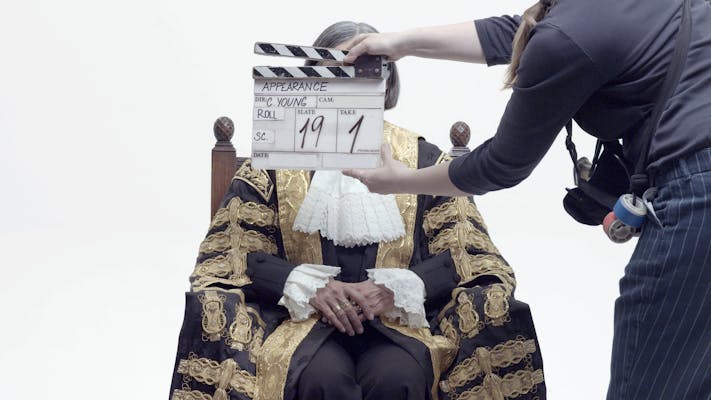The glow of an immense screen lights up a vast, dark atrium. The set-up onscreen is simple: a seamless white backdrop, a smattering of cameras and sound rigs in the foreground, and a chair cushioned with red leather. It feels almost as though you could walk into it - that is until the seat is occupied. Over the course of Carey Young’s Appearance, 15 British female judges of varying ages, ethnicities, backgrounds and seniority will fill that chair, their only instruction to interact with the camera as they see fit.
Young takes explicit inspiration for the concept from Andy Warhol’s Screen Tests, his series of silent black and white video portraits that captured bohemian luminaries such as Edie Sedgwick, Nico and Bob Dylan. But with the stark and crisp macro-detail of modern camera technology, Young is also able to achieve an almost confrontational intimacy that puts one in mind of Marina Abramovic’s The Artist is Present (2013). Though each judge is not herself in the room, the command and quiet resolve of their gaze, their stillness, is arresting - Young jokes that observers of the piece have said they felt as though they were in the dock awaiting judgement.
And yet, it is not only the dynamic of audience as plaintiff that Young wishes to evoke. There is some punning going on in the piece’s title - ‘appearance’ referring both to presence in court and to physical presentation. The prospect of sitting for a silent video portrait is an intensely vulnerable one, after all, and as each progresses, the dichotomy between that vulnerability and the authority of their position becomes more apparent. You see the cogs turn as they decide which expression to settle on, and to which position they should shift in the chair. The little personal touches with which each has augmented their judicial garb - polished nails, bangles on the wrists, dip-dyed hair - are captured in minute detail. It was also specified that subjects not wear their ceremonial wigs; as a viewer, you sense the interiority of these women beyond their roles as figureheads for their respective institutions, a view of the law as a distinctly human and material presence that is a preoccupation of Young’s body of work.
Having researched law and its artistic potential for two decades, Young has honed a gift of granting a playful materiality to a field typically seen as dispassionate and detached. Her photographic pieces occupying the adjoining gallery are a testament to this; for instance, the two pieces forming a diptych in one corner read as abstract negatives of each other, a scattering of fine white perforations on a black surface on the left against the reverse on the right. But on further inspection, we discover their respective origins - one, a close-up of a pinboard in Oxford’s Faculty of Law, the other an eroded prison wall in Belgium. Faculty of Law, Oxford (2022) and Prison Yard, Berveren, Belgium (2022) invite us to conceptualise law as a physical presence, the human impact on these surfaces reflecting the consequences and responsibilities one sphere owes to the other.
This can be seen too in World Court (2023), a Rothko-esque swirl of deep red that is, in fact, a close-up of the agitated velvet of the judges’ table at the International Court of Justice at the Haig, or the bright blocks of blue and orange and graphic replicating grids that reveal themselves to be the prison yard and gym of Leuze, Belgium. Young grounds the seemingly abstract concept of legislation within the context of active human participation, emphasising that it is only through our collective consent that such contracts can exist, In several cases, this is enacted quite literally, as in Declared Void (2023), a space in which any viewer that chooses to occupy it legally declares themself a member of the EU, or the wry and haunting Obsidian Contract (2010) which draws on the occult tradition of the black mirror, through which a contract written on the wall must be read in reverse.
Appearance is also accompanied by two video installations of previous works by Young; the first, The Vision Machine (2020), takes place in the SIGMA Corporation’s lens manufacturing factory in Japan. Young very deliberately focuses her camera on the female employees at every stage of the lens crafting process, paying particular attention to the technical precision with which they accomplish their tasks.
Though this is of course taken from life, there is also a meditative quality in this focus, enhanced by a mesmerising soundscape and extreme close-ups of the lenses themselves that push them into the realm of abstraction. One shot in particular, held on the red hot lenses travelling through the kiln at speed, puts one in mind of city lights as seen from a plane window. We are placed in an environment of speculation and aesthetic malleability as we see women in complete control of photography and cinema’s physical infrastructure, a stark contrast to the field as it currently stands.
Similarly, Palais de Justice (2017), filmed over the course of two years, follows the everyday movements of female judges and lawyers working trials at the main courthouse in Brussels. Again a huge screen presents the palatial atrium as though you yourself could set foot on the marble, before we delve into the minutiae of its corridors. Young consciously draws attention to the chambers as an inhabited and often intensely personal space, justice as everyday work rather than simply rarefied principle.
Since she did not technically have permission to film on site, many of the shots have a surreptitious, furtive quality to them, captured through porthole windows or around corners. The sonic texture of voices echoing of the marble carry a choral sensibility, the judicial answer to a Gregorian chant. The proceedings captured are intimate but unglamorous. The real strength of Young’s representation of women occupying these spaces with the equity of their male colleagues is in presenting it without sensation; an unquestioned default, rather than a curiosity.
If I have one quibble, (and maybe this is just my anarchist leanings kicking in here), one wonders, in a contemporary climate where public trust in our systems of justice is rightly at its lowest ebb in decades, where Young could push even further in her examination of these power structures. I certainly don’t wish to downplay how refreshing it is to see the representation of women from all walks of life within a field that still maintains a deserved reputation as a boys’ club. I especially appreciate the inclusion of Dr Victoria McCloud, the first trans woman to practise as a barrister and be appointed as a judge in 2006, as often artistic visions of female-centred power structures can get frustratingly cis-normative.
However, there are prejudices at the core of our justice system that go well beyond the gender of the person that takes the stand, and while within that system there are absolutely cases that would benefit from the presiding of a moderator who is not straight, white, cis and/or male, representation can only take you so far if the institution you’re representing maintains those prejudices in its bones. There is a limit to how emancipatory we can really be if we conclude that the solution is to put different people in charge of those legislative structures, rather than examine the possibility of new ones altogether. I’d be intrigued to see more works from Young that examine the potential of more active, radical reform within the courts, especially since she clearly has such a uniquely humanistic, imaginative and visually eloquent eye for them.
With that said, the first steps to attain those loftier aspirations lie in recognising that humanity is (or should be) at the core of our governance. Appearance is an almost spiritual communion with that fact, an exhibition in which you must invest time and active participation in order to fulfil its contract. It’s not quite a call for revolution, but it grants law a soul with a potency that demands you bear witness.




